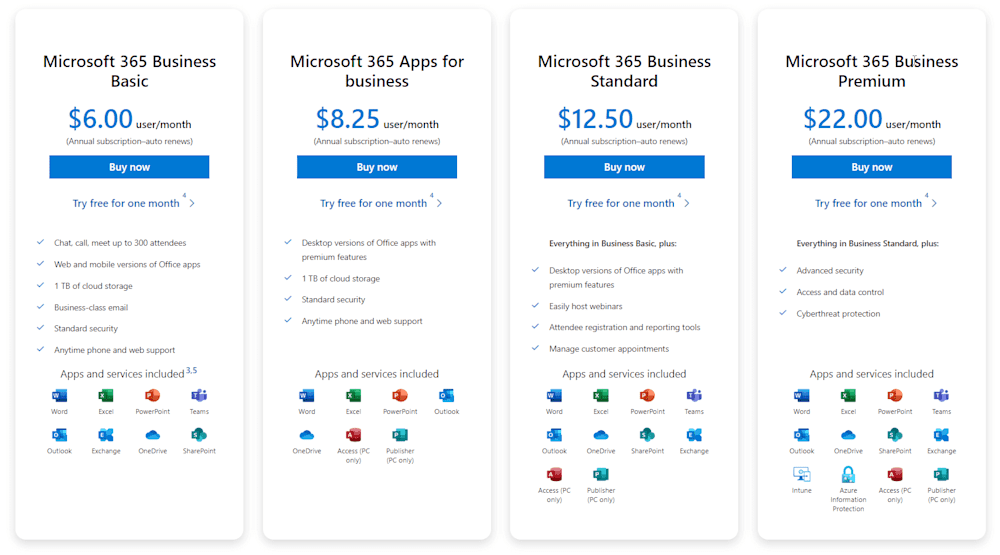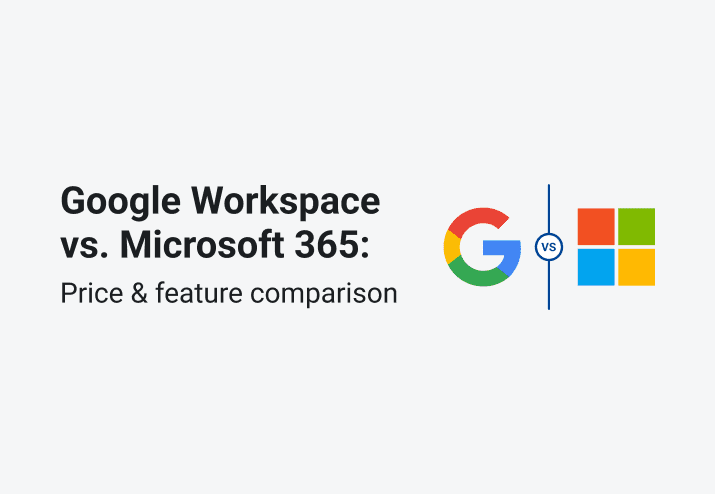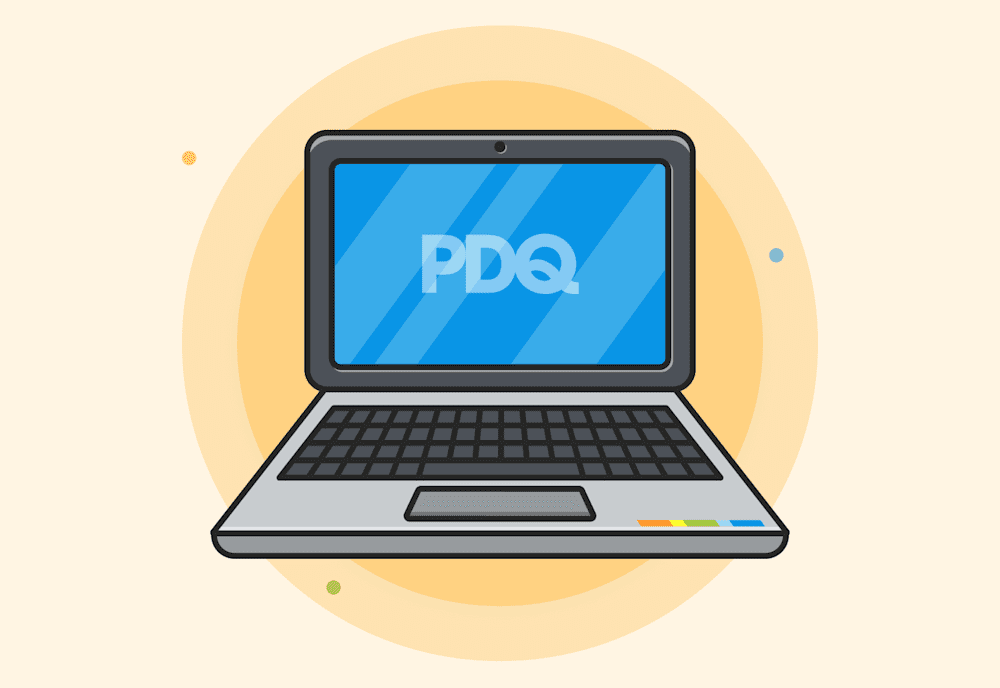Luke Skywalker vs. Darth Vader. The Avengers vs. Thanos. Batman vs. the Joker. The world is full of rivalries, but few are more heated than the epic battle of the ages: Google Workspace vs. Microsoft. Each is a hero in its own right, improving workplace productivity through convenient, collaborative apps that support everyday business tasks. But with each offering so many powerful features, choosing sides is tricky. We’ll compare the two to help you decide which is best for your business.
Google Workspace
Formerly known as G Suite, Google Workspace is a collection of productivity and collaboration tools from the powerhouse tech company Google.
Google Workspace pricing
Google Workspace offers four distinct plans. Each includes 12 popular Google apps. Plans vary in storage amount, security controls, number of video meetings, support, and other features.

Screenshot taken from Google Workspace's pricing page March 2, 2022
Google Workspace features
Each Google Workspace plan includes a suite of integrated core apps:
Gmail: This business email solution includes professional email addresses at your domain and filtering of spam, phishing attempts, and malware.
Google Calendar: Built for teams, Calendar lets employees share their availability for easy scheduling.
Google Chat: This messaging service supports direct messaging and group conversations.
Google Docs: As a collaborative word processing tool, Docs allows teams to work in the Google Doc at the same time or share feedback asynchronously.
Google Drive: Drive stores and shares files for convenient access.
Google Forms: With this solution, you can create forms, surveys, and questionnaires.
Google Jamboard: For a more visual presentation, Jamboard provides an interactive canvas.
Google Keep: Through synced notes, lists, photos, drawings, and audio, Keep helps you brainstorm, set priorities, and share reminders with colleagues.
Google Meet: As a video conferencing platform, participants can join Meet video calls with just one click.
Google Sheets: Sheets is a smart, collaborative spreadsheet application with AI features.
Google Sites: Sites helps you build websites without programming skills.
Google Slides: This app helps you design presentations without the need for software.
While these apps come standard with any Google Workspace plan, every plan varies in its other features. We’ll highlight some of the top components.
Pros & cons of Google Workspace
Google Workspace is a popular solution because of its ease of use, collaborative tools, and intuitive design. Google Workspace users can generally learn the applications with minimal time and effort, and working simultaneously in a document facilitates remote collaboration.
Here are some of the main advantages of Google Workspace:
Simple setup
Cloud-based storage
Real-time collaboration
Easy sharing
Web-based format
Intuitive and familiar
While Google Workspace is a useful tool for many businesses, it does have a few downsides. All of its applications are web-based, and no desktop apps are available. Some of the tools also lack the advanced functionality that some businesses prefer. Since Google Workspace cannot convert files to Microsoft 365, companies that use both cannot switch between them seamlessly.
The main potential drawbacks of Google Workspace include:
Lack of desktop apps
Google Sheets lacks the functionality advanced users expect
Cannot convert files to Microsoft 365
Microsoft 365
Previously called Office 365, Microsoft 365 is the software giant’s line of subscription-based productivity apps.
Microsoft 365 pricing
Microsoft 365 offers four business plans and three enterprise plans. They differ in their included apps, collaboration tools, security features, and more.
Business

Screenshot taken from Microsoft 365 business pricing page March 2, 2022
Enterprise

Screenshot taken from Microsoft 365 enterprise pricing page March 2, 2022
Microsoft 365 features
While Microsoft 365 plans vary in their app offerings, each includes five core apps:
Microsoft Excel: As a spreadsheet software, Excel allows you to organize data and perform calculations.
Microsoft Outlook: Microsoft’s email platform incorporates data encryption, a built-in calendar, and other features to help you stay organized.
Microsoft OneDrive: This cloud-based storage solution allows easy file access, sharing, and collaboration.
Microsoft PowerPoint: With PowerPoint, you can put together presentations with 3D objects, embedded animations, and interactive features.
Microsoft Word: This word processing software has dominated the marketplace for decades. The current iteration is full of advanced features, including translation, conversion into a webpage, 3D models, and more.
Business
Enterprise
Pros & cons of Microsoft 365
Microsoft 365’s apps have long been mainstays for many businesses. As a scalable solution, deploying Microsoft 365 gives you advanced features and a vast array of reliable tools to accommodate growing companies.
The main advantages of Microsoft 365 include:
Cloud-based storage
Scalability
Robust suite of tools
Reliability
User-friendly email
Advanced features
Desktop apps
For many businesses, Microsoft 365 is an ideal solution. However, it does have a few potential drawbacks. The most comprehensive plans are significantly more expensive than Google Workspace’s offerings. Additionally, advanced software features are frequently more difficult to learn, and some of the features are not available in browser-based applications.
The main potential drawbacks include:
Expense
Steeper learning curve
Limited features in browser-based apps
Google Workspace vs. Microsoft 365: Comparison
Pricing
While pricing for Google Workspace falls towards the middle of the average range, Microsoft 365’s plans go to the extremes. The most basic Microsoft 365 business plans are in line with Google Workspace’s offerings, but the most comprehensive option (Microsoft 365 E5) is significantly more expensive.
Storage
The most basic Google Workspace option (Business Starter) has just 30 GB per user compared to Microsoft 365’s standard 1 TB per user. That said, midrange Google plans have 2 or 5 TB per Google Workspace user, while Microsoft’s equivalent offerings provide 1 TB per user. Both Google and Microsoft offer unlimited storage for their enterprise-level plans (except for Microsoft 365 F3).
Apps
Individual plans vary in their included apps, but Google Workspace and Microsoft Office both offer solutions for spreadsheets, presentations, word processing, video conferencing, and other critical functions. However, Google Workspace’s tools tend to have fewer advanced features and are only available as web-based applications. In contrast, Microsoft Office offers desktop apps with advanced features.
Communication
Both Google Workspace and Microsoft 365 offer plans with powerful communication tools, like video conferencing and team messaging. You can also edit documents simultaneously with either service. However, Microsoft 365 requires the extra step of saving documents to OneDrive to share, whereas all Google Docs are automatically saved to the cloud for easy collaboration between team members.
Security
Microsoft’s Azure AD (included in enterprise-level plans) incorporates multi-factor authentication. This gives it an edge over Google Workspace’s two-step verification. That said, Google incorporates this extra layer of protection across all plans, including its most budget-friendly options. Plans from the two companies also frequently include additional security features, like spam filtering, data loss prevention, and data regions. However, the plans vary in their security options, with higher-end plans having more robust security features.
Support
Web and telephone support are available across Microsoft 365 plans. Most Google Workspace plans come with a standard support package, which includes a response to Priority 2 (P2) support cases within 4 hours (in local business hours). For Google Workspace, support upgrades are often available for an additional cost.
Google Workspace vs. Microsoft 365: Use cases
Google Workspace and Microsoft 365 users both sing their praises, but either may be better suited for your business depending on your needs and objectives.
Google Workspace is often preferable for:
Smaller teams
Startups
Those with lower budgets
Microsoft 365 may be ideal for:
Larger teams that need advanced features
Those that prefer a desktop app
Both options have strong reputations and loyal fans. By weighing their features and advantages, you should be able to select the best solution to enhance your productivity and get the most bang for your buck.
To further maximize your time and energy, don’t just stop at selecting between Google Workspace and Microsoft 365. Give PDQ Deploy and PDQ Inventory a try! Deploy simplifies software deployment to make patching quick and convenient, and Inventory is an easy-to-use systems management tool.
Also, don’t forget to check back in on our blog and YouTube channel for the latest details on information technology peppered with a tasteful level of guff.




